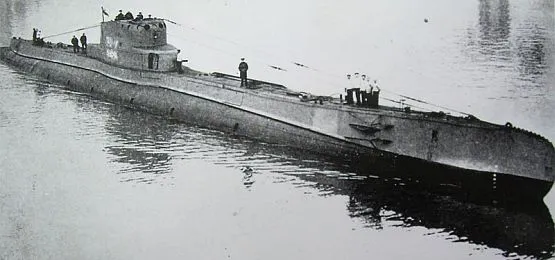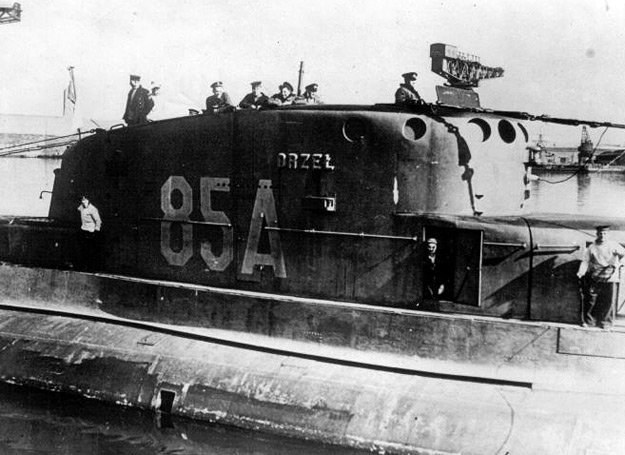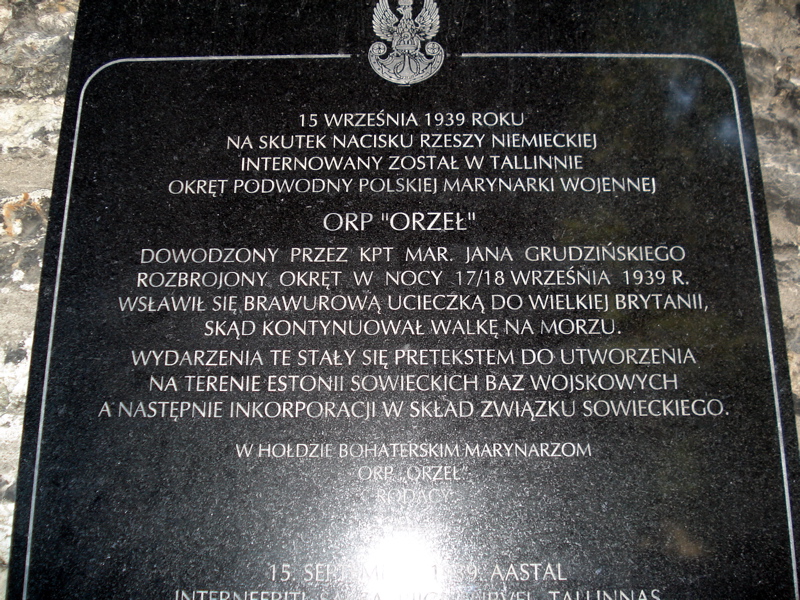Post by Bonobo on Aug 4, 2008 20:11:37 GMT 1
Tracing Polish wartime navy legend
Polish Radio
31.07.2008
An expedition of divers, maritime historians and scientists has set out from the port of Gdynia to search for the legendary Polish Navy submarine Orzel, or The Eagle, which went missing in the North Sea during the Second World War.
Slawek Szefs reports
The expedition members will attempt to locate the place where the ship might have sunk. Several possibilities must be checked as there have been various hypotheses concerning the circumstances of Orzel's disappearance in North Sea waters in the final days of May 1940. Only then will the sophisticated equipment come handy in penetrating the wreck and searching for clues to support any of the speculations about the direct cause of the submarine's sinking. One of the most probable is that the ship ran into a mine field, says Krzysztof Piwnicki, head of the expedition. Another possibility is that Orzel had become the accidental victim of an attack by a friendly ship.
'This theory was put forth by Mr. Przadak who was the bosun from Orze³. He did not go to sea on what turned out to be its final voyage because he was in hospital at the time. He later passed information that the communications officer from the base ship of the 2nd submarine fleet to which Orzel had been assigned heard a radio exchange stating the Polish sub had been hit by four torpedoes fired from a Dutch submarine.'
Once the wreck is located, and this is something the the expedition members are absolutely certain of, on-the-spot examination is sure to solve many of the mysteries.
Orzel was launched on January 15th 1938 at De Schelde shipyard in Holland and commissioned on February 2nd 1939, just months before the outbreak of World War Two. The submarine was designed by Dutch and Polish engineers. Though modern for its time, it encountered some difficulty in the shallow Baltic waters because of its size.
During the less than one year duty Orzel and its crew managed a fine war service record becoming a legend of the Polish Navy. When Nazi Germany attacked Poland in September 1939 Orzel put up a lonely fight with Kriegsmarine units on the Baltic. Due to the illness of its captain, the ship had to seek shelter in the port of Tallin in neutral Estonia. Placed under arrest due to pressure from Berlin, the crew managed a daring escape. Deprived of navigation equipment Orzel literally drifted towards Rosyth in Scotland where it was subsequently based joining the ranks of British Royal Navy. The incident had been later used by the Soviet Union to justify its annexation of Estonia on claims it had not adhered to principles of neutrality. Serving in the British naval forces Orzel took part in numerous convoys. It is also credited with sinking the clandestine German troop carrier Rio de Janeiro in April 1940 which revealed Nazi plans of invading Norway. On May 23rd Orzel set out on a succesive patrol mission never to return.
What makes the history of the Orzel important for so many generations of Poles? Pofessor Jan Ciechanowski from London, a member of the Anglo-Polish Historical Commission.
'First of all, it testifies to patriotism and saemanship of the Polish submariners. It is a very unique and inspiring story. The Polish Navy was attached to the British Navy at that time. And the services of the Polish Navy were highly valued by the British. Of course, not only Polish sailors and Polish airmen. Obviously the closest cooperation was between Polish and British intelligence services, which lasted from the begining until the end of the war.'
The present expedition is not the first one to search for the legendary Orzel submarine. Several, including a British team, have not been able to spot it on the bottom of the cold North Sea waters. But the Poles are confident this time will be different.
Members of the Polish search expedition have pledged to leave the ship and its crew to rest in the place of their war tragedy. Only the plaque with the submarine's name is to be brought back to Gdynia, Orzel's home naval base. The exact location of the ship will not be made public to protect it from being plundered by adventure seekers.
en.wikipedia.org/wiki/ORP_Orze%C5%82



A plaque commemorating Orzeł`s escape from internment in Estonian port of Tallin.

ORP Orzeł was the lead ship of her class of submarines serving in the Polish Navy during World War II. Her name means Eagle in Polish. The ship is most notable for her escape from neutral Estonia in what is now referred to as the Orzeł incident.
Orzeł was laid down 14 August 1936 at the Dutch shipyard De Schelde; launched on 15 January 1938, and commissioned on 2 February 1939. She was a modern design (designed by Polish and Dutch engineers), albeit a bit too large for the shallow Baltic Sea.[citation needed]
Orzeł incident
At the start of hostilities Orzeł was on patrol in her designated sector of the Baltic Sea. Unable to return to the Polish naval bases at Gdynia or Hel, Orzeł had to make its way into a neutral port to offload its sick captain. The crew chose to go to Tallinn, Estonia on 14 September 1939. At the insistence of Germany, the Estonian authorities interned the crew, confiscated the maps and started to dismantle the armament. The crew decided to escape with their boat and make the perilous journey to England. Under the new command of its former executive officer, Lt.Cdr. Jan Grudzinski VM DSO, Orzeł escaped on September 18 with two Estonian guards taken captive. The Estonian and German press covering the Orzeł incident declared the two captured guards dead, yet the new captain carried them to Swedish shores and provided them with money and food for their safe return home, saying that if one is returning from the underworld he should travel first class only. Estonia's lack of will and/or incapability to disarm and intern the crew caused Soviet Union to accuse Estonia of "helping them escape" and claim that Estonia was not neutral. The Orzeł incident was used by the Soviet Union to justify the annexation of Estonia.
ORP Orzeł in the United Kingdom
Without maps or most of her navigation equipment, Orzeł remained in the Baltic Sea and the crew decided to look for some German ships to sink. No ships were sunk, but Orzeł remained in the Baltic Sea long after all pockets of resistance on Polish territory were conquered by the Nazis. She evaded the numerous Kriegsmarine ships hunting for her, and made it to Rosyth in Scotland on 14 October, where she was subsequently based.
Norwegian Campaign
After refitting and rest, Orzeł went immediately on patrol. Near the small harbor town of Lillesand in southern Norway, she sank the 5,261 ton clandestine German troop transport Rio de Janeiro[1] on April 8, 1940, killing hundreds of German troops intended for the invasion of Norway[2]. Rio de Janeiro was on her way to Bergen in order to take part in the initial landings of Operation Weserübung - the invasion of Norway and opening move of the Norwegian Campaign.
Orzeł was lost with all hands on the next patrol somewhere in the North Sea, in late May - early June 1940
More info here, in English
www.orporzel.prv.pl/
A photo story
A Polish historical film:
Internment of Orzeł
Polish Radio
31.07.2008
An expedition of divers, maritime historians and scientists has set out from the port of Gdynia to search for the legendary Polish Navy submarine Orzel, or The Eagle, which went missing in the North Sea during the Second World War.
Slawek Szefs reports
The expedition members will attempt to locate the place where the ship might have sunk. Several possibilities must be checked as there have been various hypotheses concerning the circumstances of Orzel's disappearance in North Sea waters in the final days of May 1940. Only then will the sophisticated equipment come handy in penetrating the wreck and searching for clues to support any of the speculations about the direct cause of the submarine's sinking. One of the most probable is that the ship ran into a mine field, says Krzysztof Piwnicki, head of the expedition. Another possibility is that Orzel had become the accidental victim of an attack by a friendly ship.
'This theory was put forth by Mr. Przadak who was the bosun from Orze³. He did not go to sea on what turned out to be its final voyage because he was in hospital at the time. He later passed information that the communications officer from the base ship of the 2nd submarine fleet to which Orzel had been assigned heard a radio exchange stating the Polish sub had been hit by four torpedoes fired from a Dutch submarine.'
Once the wreck is located, and this is something the the expedition members are absolutely certain of, on-the-spot examination is sure to solve many of the mysteries.
Orzel was launched on January 15th 1938 at De Schelde shipyard in Holland and commissioned on February 2nd 1939, just months before the outbreak of World War Two. The submarine was designed by Dutch and Polish engineers. Though modern for its time, it encountered some difficulty in the shallow Baltic waters because of its size.
During the less than one year duty Orzel and its crew managed a fine war service record becoming a legend of the Polish Navy. When Nazi Germany attacked Poland in September 1939 Orzel put up a lonely fight with Kriegsmarine units on the Baltic. Due to the illness of its captain, the ship had to seek shelter in the port of Tallin in neutral Estonia. Placed under arrest due to pressure from Berlin, the crew managed a daring escape. Deprived of navigation equipment Orzel literally drifted towards Rosyth in Scotland where it was subsequently based joining the ranks of British Royal Navy. The incident had been later used by the Soviet Union to justify its annexation of Estonia on claims it had not adhered to principles of neutrality. Serving in the British naval forces Orzel took part in numerous convoys. It is also credited with sinking the clandestine German troop carrier Rio de Janeiro in April 1940 which revealed Nazi plans of invading Norway. On May 23rd Orzel set out on a succesive patrol mission never to return.
What makes the history of the Orzel important for so many generations of Poles? Pofessor Jan Ciechanowski from London, a member of the Anglo-Polish Historical Commission.
'First of all, it testifies to patriotism and saemanship of the Polish submariners. It is a very unique and inspiring story. The Polish Navy was attached to the British Navy at that time. And the services of the Polish Navy were highly valued by the British. Of course, not only Polish sailors and Polish airmen. Obviously the closest cooperation was between Polish and British intelligence services, which lasted from the begining until the end of the war.'
The present expedition is not the first one to search for the legendary Orzel submarine. Several, including a British team, have not been able to spot it on the bottom of the cold North Sea waters. But the Poles are confident this time will be different.
Members of the Polish search expedition have pledged to leave the ship and its crew to rest in the place of their war tragedy. Only the plaque with the submarine's name is to be brought back to Gdynia, Orzel's home naval base. The exact location of the ship will not be made public to protect it from being plundered by adventure seekers.
en.wikipedia.org/wiki/ORP_Orze%C5%82



A plaque commemorating Orzeł`s escape from internment in Estonian port of Tallin.

ORP Orzeł was the lead ship of her class of submarines serving in the Polish Navy during World War II. Her name means Eagle in Polish. The ship is most notable for her escape from neutral Estonia in what is now referred to as the Orzeł incident.
Orzeł was laid down 14 August 1936 at the Dutch shipyard De Schelde; launched on 15 January 1938, and commissioned on 2 February 1939. She was a modern design (designed by Polish and Dutch engineers), albeit a bit too large for the shallow Baltic Sea.[citation needed]
Orzeł incident
At the start of hostilities Orzeł was on patrol in her designated sector of the Baltic Sea. Unable to return to the Polish naval bases at Gdynia or Hel, Orzeł had to make its way into a neutral port to offload its sick captain. The crew chose to go to Tallinn, Estonia on 14 September 1939. At the insistence of Germany, the Estonian authorities interned the crew, confiscated the maps and started to dismantle the armament. The crew decided to escape with their boat and make the perilous journey to England. Under the new command of its former executive officer, Lt.Cdr. Jan Grudzinski VM DSO, Orzeł escaped on September 18 with two Estonian guards taken captive. The Estonian and German press covering the Orzeł incident declared the two captured guards dead, yet the new captain carried them to Swedish shores and provided them with money and food for their safe return home, saying that if one is returning from the underworld he should travel first class only. Estonia's lack of will and/or incapability to disarm and intern the crew caused Soviet Union to accuse Estonia of "helping them escape" and claim that Estonia was not neutral. The Orzeł incident was used by the Soviet Union to justify the annexation of Estonia.
ORP Orzeł in the United Kingdom
Without maps or most of her navigation equipment, Orzeł remained in the Baltic Sea and the crew decided to look for some German ships to sink. No ships were sunk, but Orzeł remained in the Baltic Sea long after all pockets of resistance on Polish territory were conquered by the Nazis. She evaded the numerous Kriegsmarine ships hunting for her, and made it to Rosyth in Scotland on 14 October, where she was subsequently based.
Norwegian Campaign
After refitting and rest, Orzeł went immediately on patrol. Near the small harbor town of Lillesand in southern Norway, she sank the 5,261 ton clandestine German troop transport Rio de Janeiro[1] on April 8, 1940, killing hundreds of German troops intended for the invasion of Norway[2]. Rio de Janeiro was on her way to Bergen in order to take part in the initial landings of Operation Weserübung - the invasion of Norway and opening move of the Norwegian Campaign.
Orzeł was lost with all hands on the next patrol somewhere in the North Sea, in late May - early June 1940
More info here, in English
www.orporzel.prv.pl/
A photo story
A Polish historical film:
Internment of Orzeł






